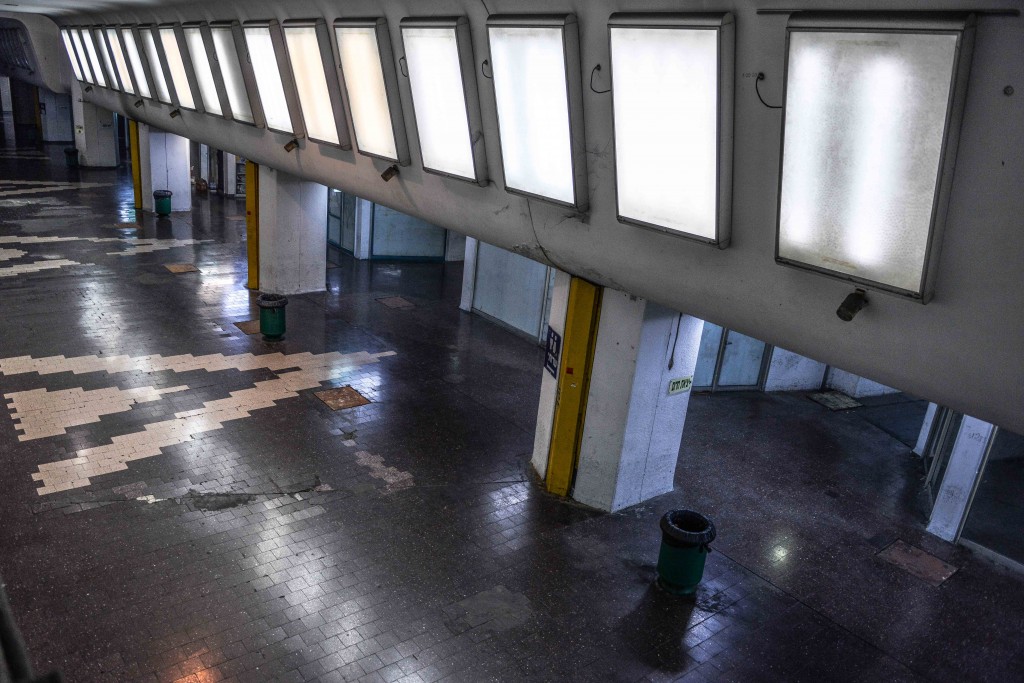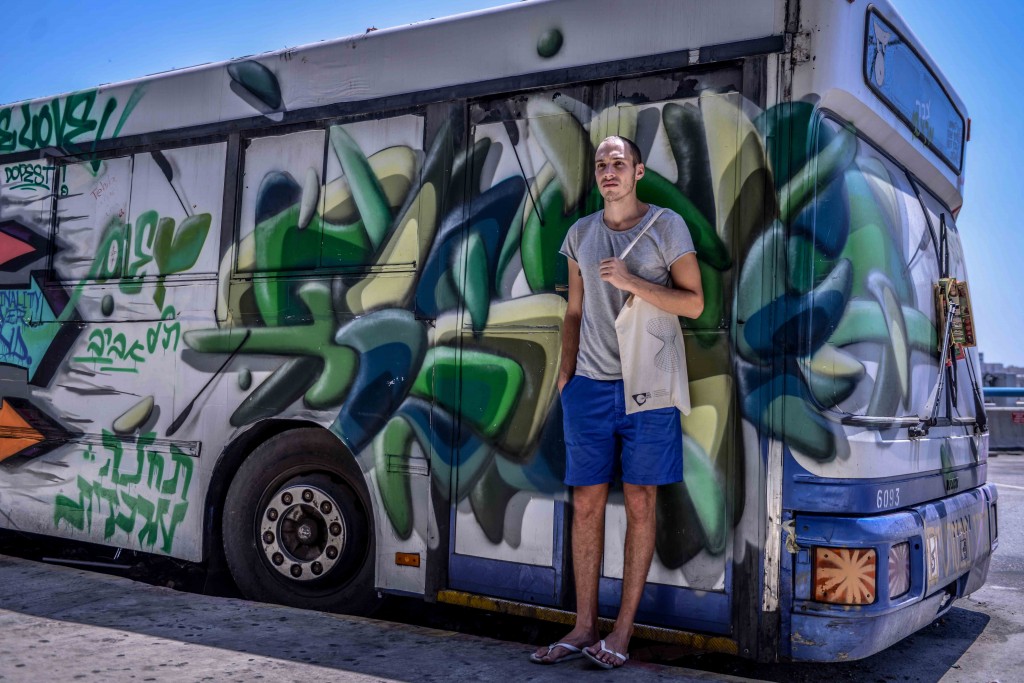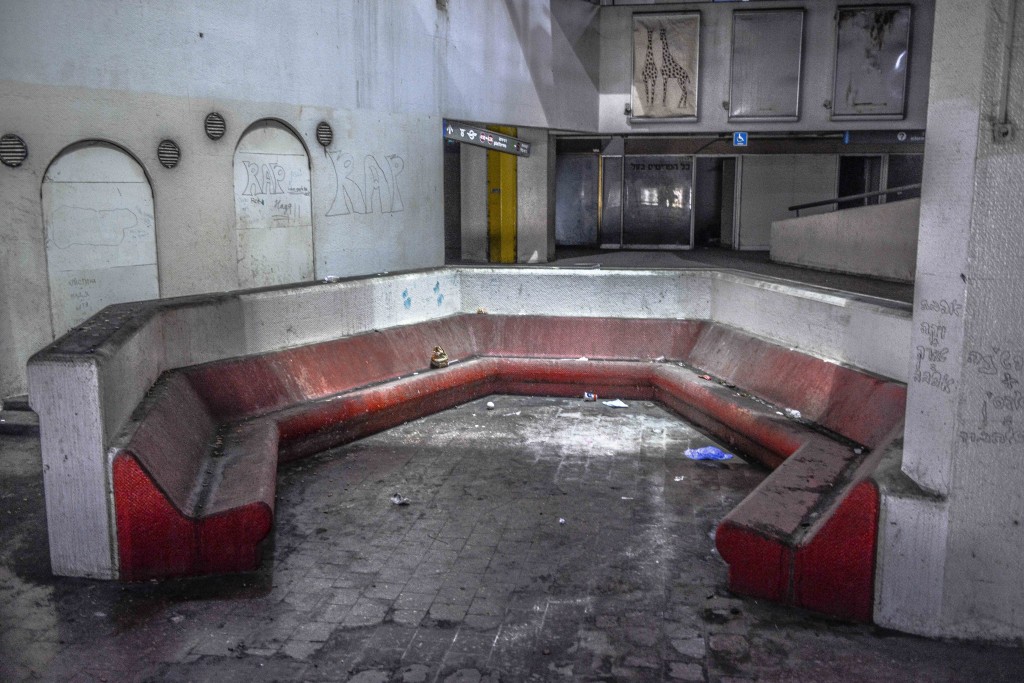It’s part concrete corn maze, part Dr. Seuss playground, and part post-apocalyptic trading post. The grungy, grimy, glorious Central Bus Station is the most fascinating building in Tel Aviv. Photos: Aviram Valdman
I’m walking up Chen Boulevard in central Tel Aviv on an especially gorgeous April day. I’ve just left work and am on my way to a private tour of Tel Aviv’s Central Bus Station, a very different place from where I am now.
Where I am now is one of my favorite streets in the city. Chen Boulevard stretches between Ha’Bimah and Rabin Squares, two of the city’s most recognizable public spaces. Its median strip is nothing less than an expansive, vertical park for bikers, pedestrians, and bench sitters drawn by the dappled sunlight filtering through the fichus trees. All around are young people walking with designer dogs and afternoon coffee drinkers, surrounded by lovely open spaces and exquisite greenery. At this moment, everything around me feels quintessentially Tel Aviv.
It’s a tribute to its designer, Sir Patrick Geddes, a Scottish city planner who, in 1925, began work on a master plan for Tel Aviv. His design was to emphasize the rights of pedestrians over the domination of the automobile, create green spaces, and encourage civic unity through the creation of large, beautiful public areas. He wanted to make Tel Aviv a garden city and, in many ways, he succeeded. But even though most tourists and many natives think of Tel Aviv in these terms, the borders of the Geddes Plan comprise a miniscule 7.5 percent of the city. I am heading toward part of the other 92.5 percent.
On the way, I bump into a couple of acquaintances from work. I’m a preschool teacher at an English nursery school in the city’s north, and one of my students, three-year-old Yona, pulls up next to me on a bicycle ridden by his father, Yuval. We say hi, I tousle Yona’s hair, and his father asks me where I’m off to.
Even though I’m on my way to the Central Station, I tell them I’m headed home, since I live a couple of blocks away from the station anyway.
He asks where I live and I say, “Levinsky Street.”
He cocks his head, not sure of where this is.
“Near the Central Bus Station,” I say.
“Oh,” he says. “Hardcore.”
Yona laughs and repeats it back, “Hardcore.”
They wave goodbye and speed-off.
I’m used to this response. It’s what all Israelis say when I reveal the scandal of my address: “Hardcore.”
Only once did I receive a different response. I was biking on genteel Balfour Street when my bicycle was hit by a car. The driver, a young Google employee, and his wife took me up to their apartment for a glass of water while he tried to fix the bicycle chain. His wife asked me where I lived and I told her I was on Levinsky Street. She didn’t recognize the name, so I said, once again, that it was by the Central Bus Station.
“Oh,” she said. “It’s nice down there. Pretty.”
After being hit by their car, this seemed like adding literal insult to injury. “Hardcore,” might not be polite, but at least it’s honest. It certainly isn’t “nice” down on Levinsky, nor is it “pretty”; and to say it is only draws more attention to the stark difference between the two poles of the city. Because, like so many places and, some think, the world in general, Tel Aviv is two cities—a wealthy, expanding north, and a poor, neglected south.
After saying goodbye to Yuval and Yona, I continue walking. I pass HaBimah and continue onto Rothschild Boulevard, the gold standard of Tel Aviv streets: gorgeous, chic, lively, and equipped with a bike lane and walking path; as well as benches, playground equipment, and coffee kiosks. Then I turn left on Shadal and, from there, straight on to Barzilai, where I come, at last, to Menachem Begin Boulevard.
And here it is: The border.
Up there is the famed White City, and down there is its prodigal son.
When you cross Menachem Begin, the environment changes very quickly. I’m now walking down Tchlenov Street between Begin and Levinsky; and Tchlenov is as “hardcore” as it gets.
The intersection is Acco Trail, a narrow throughway pockmarked with shanty huts and populated by derelict heroin addicts. After comes a street called Ha’Gedud Ha’Ivri, where an interminable construction project stirs up dust on a corner where prostitutes congregate. Then comes Y.L. Peretz Street, which boasts a number of new condo developments occupied mainly by gay men and transsexuals. And after that comes Levinsky, my current home, and finally the New Central Bus Station.
I’m only 10 minutes from Patrick Geddes’ Tel Aviv, but I’m already in another city. There are no gardened boulevards. The buildings are crumbling and covered in graffiti. African refugees in silk shirts carry crates of beer to their bar/meeting hall on the first floor of my building. The neighborhood has a stark beauty, but there’s a sense of melancholy that’s hard to ignore.
I see some friends coming out of a nearby building; fellow artist-types taking advantage of the cheap rents. We greet each other and they go on their way, probably toward the nearby Florentin neighborhood for a cup of coffee.
I pass Levinsky Park, where refugees lie on the grass and sleep in playground tubes and slides. In the oppressive afternoon heat, everything is still and quiet. I begin to wonder how it’s possible that the two halves of the city acquired such radically different characters. And I look east to find the answer.
There it is on the eastern horizon: The Central Bus Station. It looms massive and heavy over the street as I approach. Here is the central metaphor of south Tel Aviv and, depending who you ask, either the beneficiary or the cause of south Tel Aviv’s deterioration.
On the corner of Levinsky and Tzemach David, I wait to begin my private tour of the station. It’s just after two in the afternoon. The sun is high and hot and the air is thick with dust. All around is the clatter of buses and commerce. The street is typically busy, packed with the usual cross-section of south Tel Aviv’s population. There are refugees from Eritrea and Sudan, as well as migrant workers from the Philippines. Jews and Arabs bustle in and out of the station while tourists with gigantic backpacks get on and off the buses.
My guide approaches. He’s late, which means he’s on time from the Israeli perspective. Elad Horn is tall and thin, wearing sunglasses, a t-shirt, and jeans. A longtime friend of mine, it was Elad who first introduced me to the Central Bus Station and opened my eyes to its possibilities as a place of intrigue and contemplation, as well as a fantastic source of discount kitchenware.
“I’m excited for my tour,” I say.
“No, no,” he corrects me. “You don’t tour the station. You cruise the station.”
I ask him what the difference is.
“On a tour,” he says, “the tour guide decides where you go and what you see. On a cruise, the station decides.”
With this gnomic statement in mind, we head to the fourth floor of the station via the Levinsky Street entrance. A guard checks our bags and we find ourselves in a long corridor filled with shops, selling everything from canaries to wigs. Passing through, we emerge into a gallery of vaulted ceilings; a temple of cheap merchandise boasting one of Israel’s first McDonald’s, an Asian grocery store, and racks and racks of bargain apparel.
“I have those slippers,” Elad says, pointing. “I highly recommend them.” They’re a steal at twenty shekels. I pay the vendor and put the slippers in my bag.
As archivist for the station’s architect Ram Karmi, who died in 2013, Elad is an expert on the history of the site’s planning and construction. But it is as a cruiser of the Station, I presume, that he has come to acquire his intimate knowledge of bargain slippers.
We pass a Druze woman spreading labane cheese on pita fresh from a traditional taboun oven. She stands behind the folding table from which she also sells honeycomb honey and olive oil.
“Best pita in the station,” Elad says. “Maybe we’ll stop in after we’ve tired ourselves out a bit more.”
He places a “maybe” before each of his suggestions, reinforcing the idea of a “cruise,” in which the Station dictates and we obey. While it’s a mindset we enter into willingly, it’s also architecturally inevitable. The station’s layout is like an M.C. Escher painting. From above, it resembles a massive Hebrew letter “Resh,” but from within, it appears to have no geometrical organization whatsoever.
One could just as easily draw comparisons to Lewis Carroll and Jorge Luis Borges: The station is a labyrinth. Its scale changes rapidly, cramped passageways spill out into vast open areas, nonsensically placed escalators cut across the space seemingly at will, and vividly painted pipes crowd the tiled walls.
There’s a local saying that the Central Bus Station is the only thing that brings the Israeli population to consensus: Everyone hates it. There’s something to this. Most people will tell you that the station is a grotesque eyesore, inconvenient and ugly; as well as a pox on any city street unlucky enough to be its neighbor.
But the truth is more complex than that. And as we cruise, the Station begins to reveal to us its many faces.
The history of the Central Bus Station mirrors the site’s convoluted interior. Ground was broken on December 14, 1967. It finally opened for business 26 years later. The original plan was to build the world’s largest bus terminal—a title usurped only recently by India—but the plan started to fall apart right from the beginning. Early financial difficulties halted construction, earning it the nickname “Tel Aviv’s White Elephant.” Attempts to alter the plan and make it financially viable slowly mutated its form, giving it the form it has today.
Its official name is “The New Central Bus Station,” but since it’s already bankrupt and covered with dust, most people refrain from calling it that. It is simply “The Central Bus Station,” distinguished only by people’s habit of referring to its predecessor—demolished in 2009—as “The Old Central Bus Station.”
The original blueprints and sketches show a gleaming palace; a metropolis within a metropolis, filled with fashionable shoppers, places to rest and relax, and a clean, organized flow of bus traffic. But today, approximately half the station is deserted. Originally comprised of six floors, a seventh floor was added in 2002, and when most of the bus traffic was transferred there, many of the businesses on the lower floors died.
But here on the fifth floor, above the mania of shoe stores and falafel restaurants, hidden cultural gems can be found. Elad takes me inside Yung Yiddish, a non-profit Yiddish library. In this tiny space, one can peruse a collection of approximately 50,000 Yiddish books and periodicals. One of the walls is completely constructed out of books, and the tables are lined with newspapers weighted down by magnifying glasses. Examining one paper, I begin to notice familiar street names. It’s the real estate section from a 1920’s paper featuring properties in the Williamsburg neighborhood of Brooklyn, where I lived before I came to Tel Aviv.
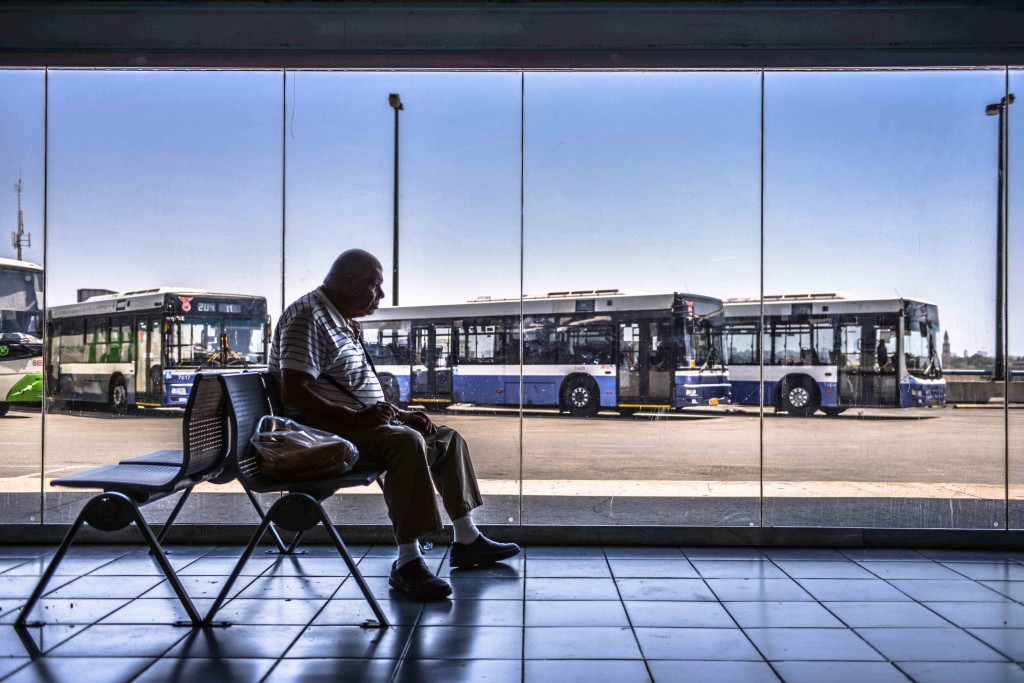
5,000 buses come through the Tel Aviv Central Bus Station every day. Photo: Aviram Valdman / The Tower
Speaking with Mendy Cahan, the founder of Yung Yiddish, I learned that this location—he runs another branch in Jerusalem—was opened in 2006. When I ask why he chose the station, he has his list of answers ready. I think he gets this question a lot.
“Firstly,” he says,
I chose it because we are a completely non-profit organization and I needed a lot of space for my books. This was the cheapest way I could get that. Secondly, I wanted the space to be central in a national sense, and the Central Bus Station allows easy access from all parts of the country. Thirdly, I was expecting, because it is a downtrodden area, that I would get a reduction in property taxes from the municipality. But the municipality has done little to help us, and it’s been an ongoing battle.
Mendy’s shop is not alone. There are a number of cultural events and institutions here. A gallery space, also on the fifth floor, has housed the work of prominent Israeli artists; and the space outside Yung Yiddish was recently converted into an exposition for self-published ‘zines and art books.
Mendy recalls that the station’s arts culture existed even before his arrival. At that point, there was already a plan to establish an artists’ compound in the station; and back in 2000, the artists’ studios on the fifth floor were very active. By 2006, however, they were mostly empty.
“I saw it going down,” he says of the Central Bus Station’s artists’ community. “And now again there is interest.”
Lack of support from the municipality makes Yung Yiddish right at home with the station’s other marginalized communities. “Because we are poor, we serve others who don’t have decent budgets and we help each other out,” he says. As a result, the space serves as an affordable venue for those seeking a place to work on their art and music: “It became a hub for creativity far beyond our expectations.”
Over the years, the merchants and artists have also become close to the refugee and migrant communities. He tells me about the “Cabaret for the Poor,” in which refugees and migrants were given a space to express themselves creatively, letting others witness their voices, music, and talents.
As Mendy talks, he articulates the charm of the Station, generally called indefinable or chalked up to an ironic, kitschy appeal. But the story of Yung Yiddish points to something very real that is, in many ways, the source of the station’s value: It is a place for the placeless.
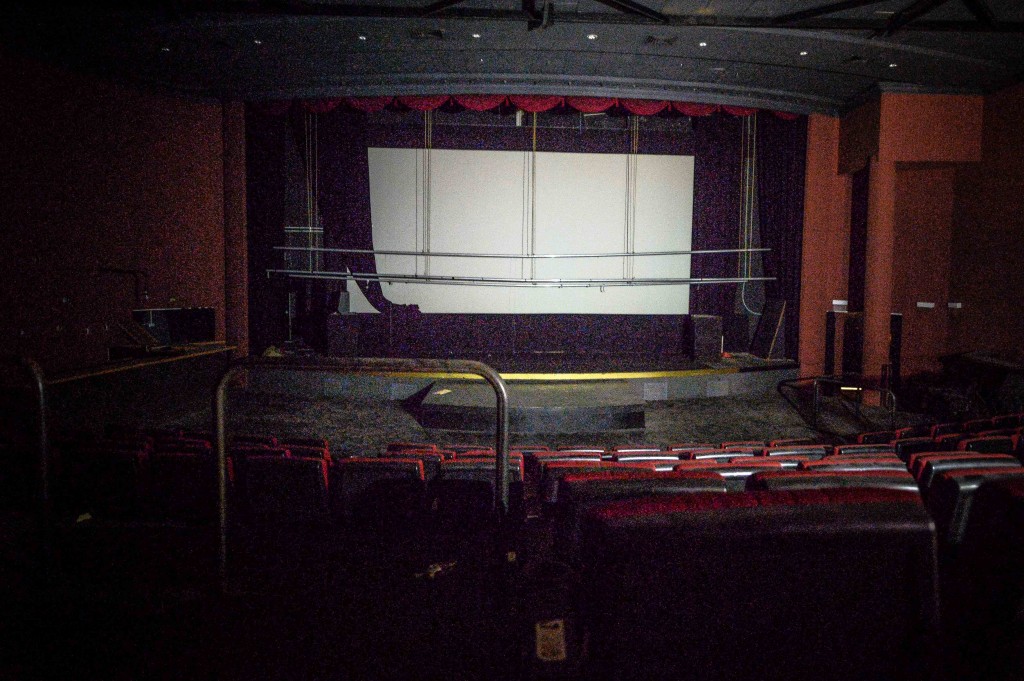
The bus station contains an abandoned movie theater with six screens. Photo: Aviram Valdman / The Tower
Elad and I depart and continue to cruise the commercial section of the Station. We see the nursery school where refugee families send their children, the school where immigrants from the Philippines are certified in eldercare, and the post office where foreigners from all over send money back home. We see places of business. We see hair salons and artists’ studios. We see an old woman reading fortunes and soldiers arriving home for the weekend.
“That’s enough of that,” Elad suddenly announces. We stop short and he gestures toward a downward ramp, heading away from the crowds and stores into a place that looks quiet and empty and stale. “I think you’re ready to go underground.”
Elad and I descend into the depths of the Station. Here, there is little light and the air is musty. I tense up as we emerge on the second floor, a modern—albeit a very ’70s take on “modern”—arcade overlooking the first floor below us. I step carefully, ever aware of the possibility of rats, cockroaches, and squatters. But this place seems truly abandoned. Nothing stirs. Nothing lives.
We approach an open area. Benches form a pentagonal shape surrounding an empty space. “Karmi envisioned the station as a city within a city, complete with parks,” Elad says. “The ceiling was going to be open here. This would be a place where you could bring a cup of coffee and a book while you waited for your bus.” I look up to find myself greeted by a grim cement ceiling. Above us, on the third floor, people chatter and spend; but here the hallways are lined with empty storefronts, most with their glass windows smudged and shattered.
We pass an out-of-service escalator and an eerie statue of Charlie Chaplin to reach the station’s six abandoned movie theaters. The seats are clean and comfortable looking. The screen is black and unmarred. It looks more like a theater ready for its grand opening than a cinema years past its own demise. “They used to show films here in the ‘90s,” Elad says. “And then it became an X-rated movie theater. Then it closed.”
I ask Elad for some hard numbers. He has them ready, of course, because he’s often asked to tell the story of the station in numbers. After all, it’s always the temptation, when observing something truly massive or awe-inspiring, to reduce it to figures.
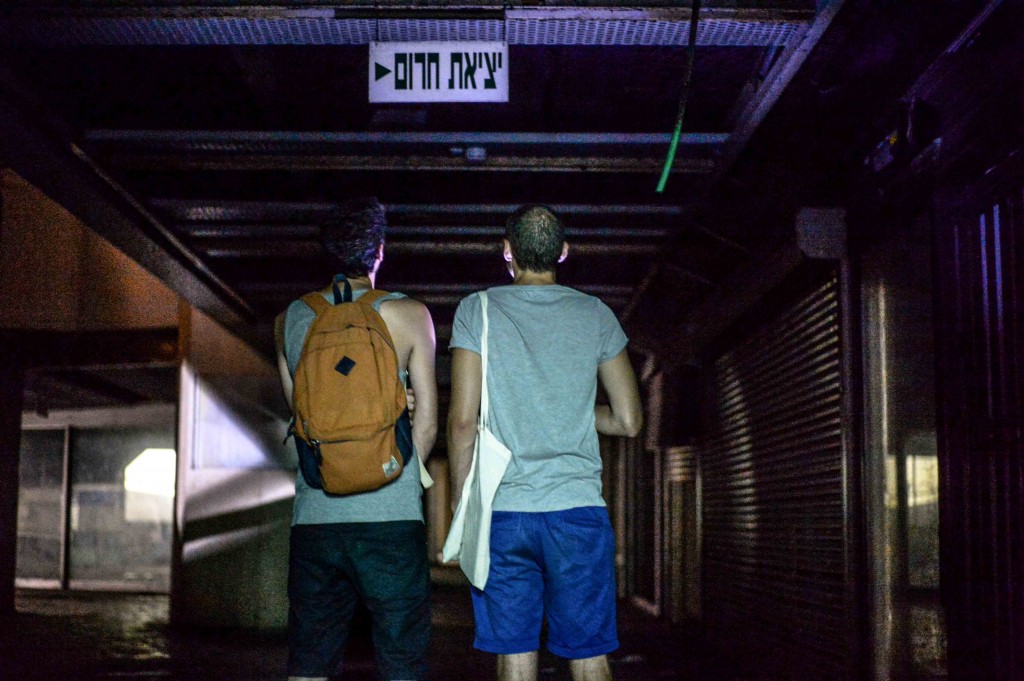
Elad Horn and Matthew Schultz descend into the bowels of the Station. Photo: Aviram Valdman / The Tower
The station, Elad explains, comprises 230,000 square meters. It’s home to approximately 650 businesses and has 80,000 visitors a day. There are 12 operating entrances. It sits on 42 dunams of land. If you walk from bottom to top, cruising through all publically accessible places, you cover seven kilometers. 5,000 buses come and go every day.
“Behold the shelter,” Elad says. “15,000 square meters, in case you were wondering.” We enter the station’s bomb shelter, the largest in the country. “It was used once,” he notes, “in 1991 during the Gulf War.” It looks like an empty parking lot. There is nothing special about its appearance, but the air is staler than anywhere we’ve been so far. It’s impossible to flee from the image of this empty space filled with frightened people waiting for the all-clear signal. I shiver a bit and ask if we can move on.
A short walk from the shelter is where the maintenance staff stores its equipment. “Let me check on something,” Elad says. He walks behind some garbage cans, arrives at a small door, and jiggles the handle. “Locked,” he says. “I’ve never been back here, but I have a suspicion I should.”
The wall above the door doesn’t even reach the ceiling. “I bet we can get over it,” I say. “Give me a lift.” Elad knits his fingers together and lifts me up. I scramble over the wall and he follows, stacking some cinder blocks to make the climb.
We find ourselves in a long, dark corridor. It’s only wide enough to walk single file, and even then we have to wrap our arms tight around ourselves. The walls are lined with thick, ominous black tubes. These are the electrical cables that power the entire facility; pulsing right beside us is the nerve center of the station. With trepidation, we walk further and further with no idea where we’ll end up.
The corridor narrows even more and curves slightly. Looking behind us, we can no longer get a clear glimpse of the door. I wince as I step over the skeleton of a kitten; and then, finally, we emerge into a strange chamber. Here there is nothing but a door marked with a skull and crossbones.
“Look!” Elad says. He gestures past my shoulder and I turn. The wall behind me is covered in mysterious carved hieroglyphs. On closer look, it’s just Hebrew, but scrawled on the dusty wall it looks like the Rosetta Stone.
“Names and dates,” Elad says. “A friend of mine who works for security told me about this. It’s everyone who has ever done security work here for the past 20 years.” We know we shouldn’t do it, but we can’t resist. We carve our own names in the wall. Then we venture back into the artery through which we came, scurrying again—with some difficulty—over the door.
By now I’ve become accustomed to the dark and the quiet. I’m no longer afraid and am almost reluctant to leave this place and return to the surface. But my stomach is growling. I think back to the woman and her taboun. The cruise calls us onward and upward.
There are questions but no answers when it comes to the future of the Central Bus Station, and south Tel Aviv in general. Though the station is bankrupt and despised, demolition seems unlikely. With its real-estate shared between private and public owners, no consensus could be reached on such a measure. Beyond that, demolition would unleash a cloud of pulverized concrete that would envelop almost the entire city.
There has been some renewed interest in the place. Elad and his partner Talia Davidi have published booklets about the station’s history, including its quirks and secrets. They also hosted an exhibit of the station’s archives in its main gallery, entitled “Labyrinth.” And despite everything, the station remains an economic and social center for those on the fringes of society: Refugees, migrants, artists, prostitutes. Even a colony of bats has found refuge there, nesting in such large numbers in one of its many abandoned terminals that the station has become an officially protected bat preserve.
All of this keeps the Station alive, but just barely. Reviving the station as a whole seems like a remote possibility. In 2014, having “the world’s largest bus terminal” hardly seems like an enviable achievement. Karmi’s vision of a gleaming microcosmic municipality seems almost antiquated and naïve.
But those like Horn and myself, who see in the Central Bus Station something fascinating and transcendent, will always be thankful for its presence. Horn and Davidi like to discuss initiatives to save the station but, when I ask him to get more specific, he hesitates. “It’s hard to say,” he says at last. “I like her just the way she is.”
![]()
Banner Photo: Aviram Valdman / The Tower






